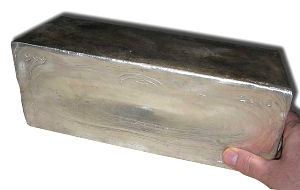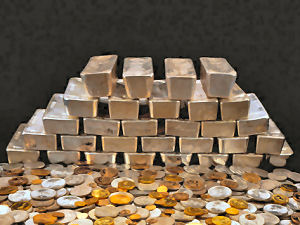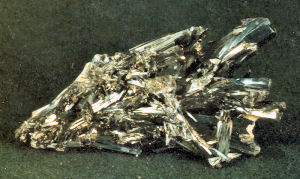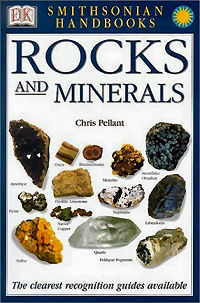
HOME
INTRO
SYMBOLS
ALMANAC
ECONOMY
GEOGRAPHY
STATE MAPS
PEOPLE
FORUM
NEWS
COOL SCHOOLS
STATE QUIZ
STATE LINKS
BOOK STORE
MARKETPLACE
NETSTATE.STORE
NETSTATE.MALL
GUESTBOOK
CONTACT US


Texas State Precious Metal

Texas State Precious Metal: Silver
Licensed under the Creative Commons
Attribution-Share Alike 3.0 Unported license.
House Concurrent Resolution No. 102, authored by State Represtative Pete Gallego and filed on February 19, 2007, makes a case for silver's historical and economic significance to the Lone Star State.
H.C.R. No. 102
HOUSE CONCURRENT RESOLUTION
WHEREAS, The State of Texas has customarily recognized a variety of official symbols as tangible representations of the state's culture and history; and
WHEREAS, The precious metal silver has played a prominent role in the story of the Lone Star State, and it continues to be a visible part of Texas culture, reflecting the enduring influence of Spanish colonial design and the western heritage that is so much a part of the state's lore; and
WHEREAS, Silver has been mined in Texas for more than three centuries, beginning shortly after the Spanish established their first permanent settlements in the area in the late 1600s; the first mines were founded by Franciscan friars who dug for silver deposits near El Paso, and these same sites were worked periodically for the next 200 years; and
WHEREAS, In the late 1800s, prospectors began exploring other parts of West Texas, with figures such as John W. Spencer, Samuel B. Buckley, Lieutenant John L. Bullis, and Colonel William R. Shafter focusing their efforts on Presidio County; this led to the opening of the Shafter Mining District, which was the site of the famous Presidio Mine; operated between 1884 and 1947, it produced more than 90 percent of all the silver that has ever been mined in Texas and became a prominent business that spurred greater development in the Big Bend region; and
WHEREAS, Other mining districts in the state also yielded silver; Hudspeth and Culberson Counties were home to the Van Horn-Allamoore and the Plata Verde Districts, and Hudspeth County also contained the Quitman Mountains District; in addition, Brewster County was the site of the Altuda Mountain District, and mining took place at locations in Llano, Mason, and Gillespie Counties in the Hill Country; in total, Texas mines yielded more than 33 million fine ounces of silver, which had a value of nearly $23.5 million, between 1885 and 1952; the manual labor of carving these riches from the rocks fell to a hardy group of miners who, in true Texan fashion, used their skill and determination to complete a difficult and dangerous job; and
WHEREAS, Most mining came to an end in the 1950s, but interest in harvesting the state's silver deposits continues; 20 million troy ounces of the metal are believed to still remain in the Shafter Mining District, and resources of this kind may prove profitable given silver's widespread use in commercial and industrial applications, where it plays a role in everything from photography to coin making, x-rays, water treatment, and electronics; and
WHEREAS, Jewelry makers and other artisans also rely on this precious metal, and the stately sheen of silver is a key element in beautiful stylistic designs, both rustic and refined, that can be seen throughout Texas; in belt buckles, tie clasps, and boot decorations, it is a staple of the western-wear fashions that harken back to the state's pioneer past; moreover, silver's rich, pure luster also makes it a favorite material for religious jewelry and other devotional objects, as well as any item or decoration that may benefit from its luxurious, glittering hues; and
WHEREAS, In both its historical and economic significance and its enduring connections to Texas imagery and culture, silver is a fitting symbol for the state and its people, and it is indeed appropriate that this metal receive special legislative recognition; now, therefore, be it
RESOLVED, That the 80th Legislature of the State of Texas hereby designate silver as the official precious metal of Texas.
Silver became the official precious metal of the State of Texas when Governor Rick Perry signed House Concurrent Resolution No. 102 on June 15, 2007.
Texas Law

Texas State Precious Metal: Silver
Photographs
Silver was named the official precious metal of the State of Texas by House Concurrent Resolution and is not, therefore, listed in the Texas Statutes.
Only a few of Texas' myriad symbols were actually adopted by an act of the legislature and written into the Texas Statutes.
Sources...
The State of Texas. Legislative Reference Library. House Concurrent Resolution No. 102. Austin: The State of Texas, 2007. Web. .
The State of Texas. Texas Legislature Online. Texas Statutes. Austin: The State of Texas, 2012. Web. .
Additional Information

Texas State Precious Metal: Silver
Presidio Mine (undated photograph)
Silver the Element: The Silver Institute: a nonprofit international association.
The Precious Metal Silver: DesertUSA.com, Digital West Media, Inc.
SILVER MINING: Texas State Historical Association: The Handbook of Texas Online.
SHAFTER MINING DISTRICT: Texas State Historical Association: The Handbook of Texas Online.

Texas State Precious Metal: Silver
Silver in History: The Silver Institute: a nonprofit international association.
More symbols & emblems: Complete list of official Texas state symbols from NETSTATE.COM.
Eyewitness Books: Rocks & Minerals, by Chris Pellant, R.F. Symes 72 pages. DK CHILDREN (August 2, 2004) Reading level: Ages 9-12. Here is a spectacular and informative guide to the amazing world beneath our feet. Stunning color photographs of rocks, fossils, minerals, precious metals, crystals, jewels and gemstones give the reader a unique "eyewitness" insight into the evolution and composition of the Earth. See rocks that have come from outer space, stalactites as old as dinosaurs, the strange and beautiful shapes of natural crystals and priceless nuggets of gold, silver and platinum. Learn what the Earth is made of - and how its rocks were formed, how early humans made the first flint tools and how diamonds and precious stones are cut, polished, and made into jewelry. Discover how prehistoric animals are preserved today as fossils, how volcanoes work, how rocks are formed from molten lava, how minerals and metals are mined and how pebbles on the seashore are worn down into sand, and much, much more!
Eyewitness Workbooks: Rocks & Minerals, 48 pages. DK CHILDREN; Workbook edition (June 16, 2008) Reading level: Ages 9-12. Perfect for getting ahead at school or just stimulating children's interest, this groundbreaking series of workbooks leaves the competition in the dust, with exciting subjects, 48 full-color pages, a turn-and-learn info wheel, and special carrying folders. Never before have there been workbooks with so many opportunities for fun and interactive learning!

Rocks and Minerals
by Chris Pellant
Smithsonian Handbooks: Rocks and Minerals, by Chris Pellant. 256 pages. DK ADULT; 1st edition (September 1, 2002) The Smithsonian Handbook of Rocks and Minerals combines 600 vivid full--color photos with descriptions of more than 500 specimens. This authoritative and systematic photographic approach, with words never separated from pictures, marks a new generation of identification guides. Each entry combines a precise description with annotated photographs to highlight the chief characteristics of the rock or mineral and distinguishing features.
Rocks & Minerals, by Dougal Dixon. 160 pages. Fireside (August 15, 1992) Beginning with a history of the earth's formation and development, this book explores the substances that compose the planet, movements within the earth, the surface effects of weather and water, and underground landscapes. It shows you how to search for, identify, and extract samples of various rocks and minerals, and for each rock and mineral type there is a brief mineralogy and explanation of its locations. There are also sections on mapping, preparing, and curating specimens, and geological sites on the six continents. Packed with more than 200 full-color illustrations, this comprehensive guide is the essential practical companion for natural science enthusiasts everywhere.

